Managing Innovation: Application of Blue Ocean Theory in WeWork
VerifiedAdded on 2023/01/12
|13
|3862
|66
AI Summary
This article explores the application of Blue Ocean Theory in WeWork, an American real estate organization. It discusses the principles and processes of the theory, evaluates its advantages and disadvantages, and provides examples of its successful implementation. The article also provides insights into WeWork's company background and historical development.
Contribute Materials
Your contribution can guide someone’s learning journey. Share your
documents today.
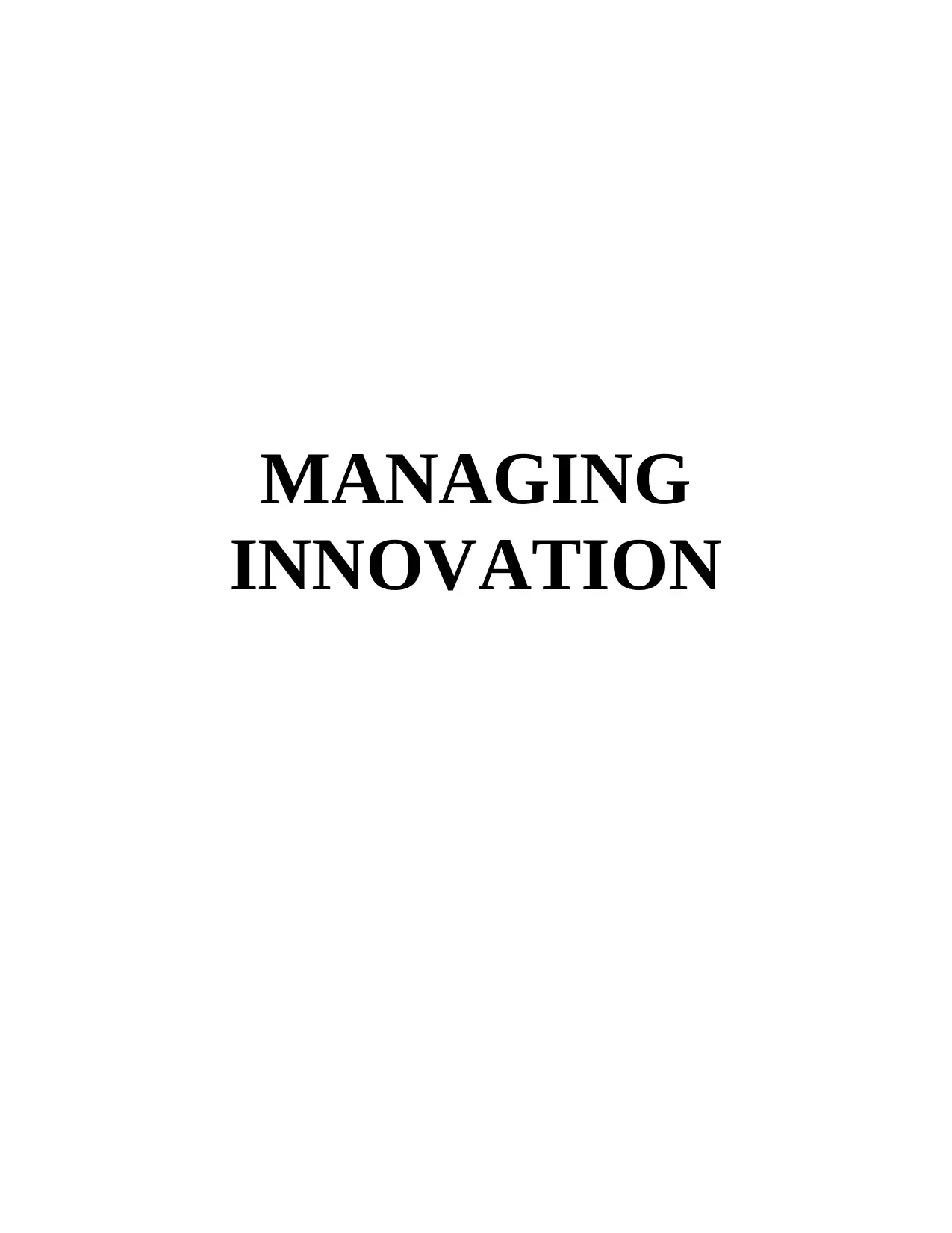
MANAGING
INNOVATION
INNOVATION
Secure Best Marks with AI Grader
Need help grading? Try our AI Grader for instant feedback on your assignments.
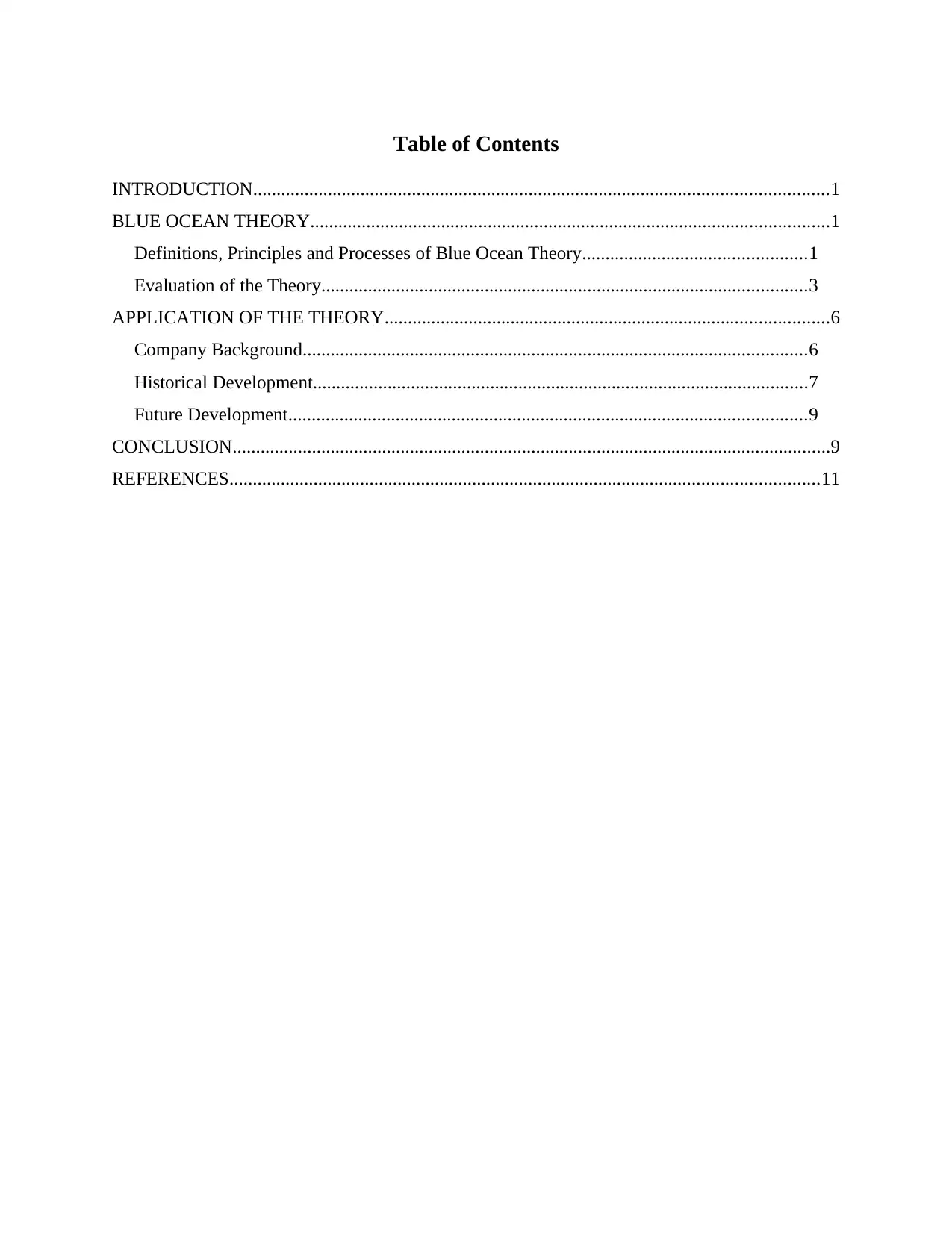
Table of Contents
INTRODUCTION...........................................................................................................................1
BLUE OCEAN THEORY...............................................................................................................1
Definitions, Principles and Processes of Blue Ocean Theory................................................1
Evaluation of the Theory........................................................................................................3
APPLICATION OF THE THEORY...............................................................................................6
Company Background............................................................................................................6
Historical Development..........................................................................................................7
Future Development...............................................................................................................9
CONCLUSION................................................................................................................................9
REFERENCES..............................................................................................................................11
INTRODUCTION...........................................................................................................................1
BLUE OCEAN THEORY...............................................................................................................1
Definitions, Principles and Processes of Blue Ocean Theory................................................1
Evaluation of the Theory........................................................................................................3
APPLICATION OF THE THEORY...............................................................................................6
Company Background............................................................................................................6
Historical Development..........................................................................................................7
Future Development...............................................................................................................9
CONCLUSION................................................................................................................................9
REFERENCES..............................................................................................................................11
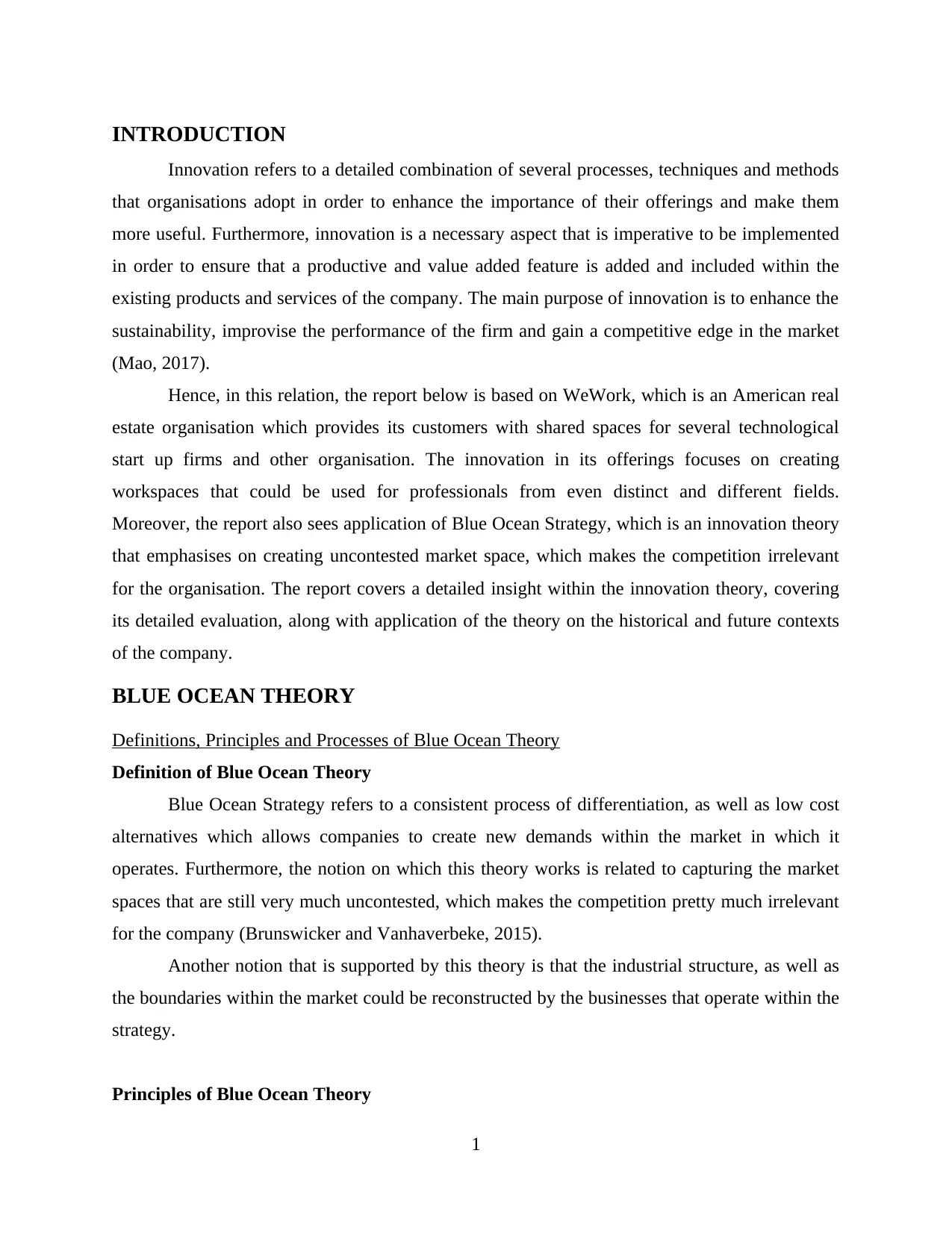
INTRODUCTION
Innovation refers to a detailed combination of several processes, techniques and methods
that organisations adopt in order to enhance the importance of their offerings and make them
more useful. Furthermore, innovation is a necessary aspect that is imperative to be implemented
in order to ensure that a productive and value added feature is added and included within the
existing products and services of the company. The main purpose of innovation is to enhance the
sustainability, improvise the performance of the firm and gain a competitive edge in the market
(Mao, 2017).
Hence, in this relation, the report below is based on WeWork, which is an American real
estate organisation which provides its customers with shared spaces for several technological
start up firms and other organisation. The innovation in its offerings focuses on creating
workspaces that could be used for professionals from even distinct and different fields.
Moreover, the report also sees application of Blue Ocean Strategy, which is an innovation theory
that emphasises on creating uncontested market space, which makes the competition irrelevant
for the organisation. The report covers a detailed insight within the innovation theory, covering
its detailed evaluation, along with application of the theory on the historical and future contexts
of the company.
BLUE OCEAN THEORY
Definitions, Principles and Processes of Blue Ocean Theory
Definition of Blue Ocean Theory
Blue Ocean Strategy refers to a consistent process of differentiation, as well as low cost
alternatives which allows companies to create new demands within the market in which it
operates. Furthermore, the notion on which this theory works is related to capturing the market
spaces that are still very much uncontested, which makes the competition pretty much irrelevant
for the company (Brunswicker and Vanhaverbeke, 2015).
Another notion that is supported by this theory is that the industrial structure, as well as
the boundaries within the market could be reconstructed by the businesses that operate within the
strategy.
Principles of Blue Ocean Theory
1
Innovation refers to a detailed combination of several processes, techniques and methods
that organisations adopt in order to enhance the importance of their offerings and make them
more useful. Furthermore, innovation is a necessary aspect that is imperative to be implemented
in order to ensure that a productive and value added feature is added and included within the
existing products and services of the company. The main purpose of innovation is to enhance the
sustainability, improvise the performance of the firm and gain a competitive edge in the market
(Mao, 2017).
Hence, in this relation, the report below is based on WeWork, which is an American real
estate organisation which provides its customers with shared spaces for several technological
start up firms and other organisation. The innovation in its offerings focuses on creating
workspaces that could be used for professionals from even distinct and different fields.
Moreover, the report also sees application of Blue Ocean Strategy, which is an innovation theory
that emphasises on creating uncontested market space, which makes the competition irrelevant
for the organisation. The report covers a detailed insight within the innovation theory, covering
its detailed evaluation, along with application of the theory on the historical and future contexts
of the company.
BLUE OCEAN THEORY
Definitions, Principles and Processes of Blue Ocean Theory
Definition of Blue Ocean Theory
Blue Ocean Strategy refers to a consistent process of differentiation, as well as low cost
alternatives which allows companies to create new demands within the market in which it
operates. Furthermore, the notion on which this theory works is related to capturing the market
spaces that are still very much uncontested, which makes the competition pretty much irrelevant
for the company (Brunswicker and Vanhaverbeke, 2015).
Another notion that is supported by this theory is that the industrial structure, as well as
the boundaries within the market could be reconstructed by the businesses that operate within the
strategy.
Principles of Blue Ocean Theory
1
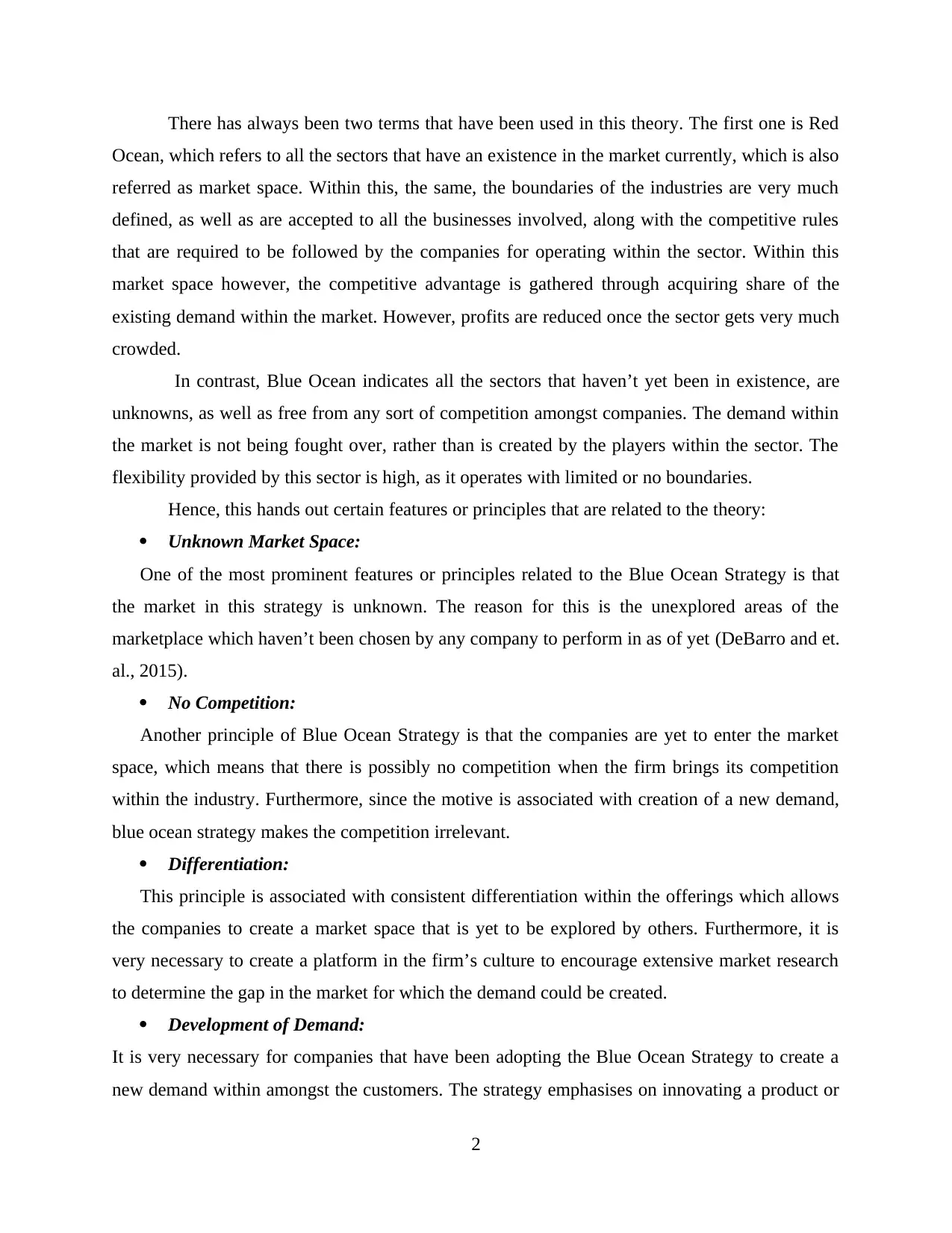
There has always been two terms that have been used in this theory. The first one is Red
Ocean, which refers to all the sectors that have an existence in the market currently, which is also
referred as market space. Within this, the same, the boundaries of the industries are very much
defined, as well as are accepted to all the businesses involved, along with the competitive rules
that are required to be followed by the companies for operating within the sector. Within this
market space however, the competitive advantage is gathered through acquiring share of the
existing demand within the market. However, profits are reduced once the sector gets very much
crowded.
In contrast, Blue Ocean indicates all the sectors that haven’t yet been in existence, are
unknowns, as well as free from any sort of competition amongst companies. The demand within
the market is not being fought over, rather than is created by the players within the sector. The
flexibility provided by this sector is high, as it operates with limited or no boundaries.
Hence, this hands out certain features or principles that are related to the theory:
Unknown Market Space:
One of the most prominent features or principles related to the Blue Ocean Strategy is that
the market in this strategy is unknown. The reason for this is the unexplored areas of the
marketplace which haven’t been chosen by any company to perform in as of yet (DeBarro and et.
al., 2015).
No Competition:
Another principle of Blue Ocean Strategy is that the companies are yet to enter the market
space, which means that there is possibly no competition when the firm brings its competition
within the industry. Furthermore, since the motive is associated with creation of a new demand,
blue ocean strategy makes the competition irrelevant.
Differentiation:
This principle is associated with consistent differentiation within the offerings which allows
the companies to create a market space that is yet to be explored by others. Furthermore, it is
very necessary to create a platform in the firm’s culture to encourage extensive market research
to determine the gap in the market for which the demand could be created.
Development of Demand:
It is very necessary for companies that have been adopting the Blue Ocean Strategy to create a
new demand within amongst the customers. The strategy emphasises on innovating a product or
2
Ocean, which refers to all the sectors that have an existence in the market currently, which is also
referred as market space. Within this, the same, the boundaries of the industries are very much
defined, as well as are accepted to all the businesses involved, along with the competitive rules
that are required to be followed by the companies for operating within the sector. Within this
market space however, the competitive advantage is gathered through acquiring share of the
existing demand within the market. However, profits are reduced once the sector gets very much
crowded.
In contrast, Blue Ocean indicates all the sectors that haven’t yet been in existence, are
unknowns, as well as free from any sort of competition amongst companies. The demand within
the market is not being fought over, rather than is created by the players within the sector. The
flexibility provided by this sector is high, as it operates with limited or no boundaries.
Hence, this hands out certain features or principles that are related to the theory:
Unknown Market Space:
One of the most prominent features or principles related to the Blue Ocean Strategy is that
the market in this strategy is unknown. The reason for this is the unexplored areas of the
marketplace which haven’t been chosen by any company to perform in as of yet (DeBarro and et.
al., 2015).
No Competition:
Another principle of Blue Ocean Strategy is that the companies are yet to enter the market
space, which means that there is possibly no competition when the firm brings its competition
within the industry. Furthermore, since the motive is associated with creation of a new demand,
blue ocean strategy makes the competition irrelevant.
Differentiation:
This principle is associated with consistent differentiation within the offerings which allows
the companies to create a market space that is yet to be explored by others. Furthermore, it is
very necessary to create a platform in the firm’s culture to encourage extensive market research
to determine the gap in the market for which the demand could be created.
Development of Demand:
It is very necessary for companies that have been adopting the Blue Ocean Strategy to create a
new demand within amongst the customers. The strategy emphasises on innovating a product or
2
Secure Best Marks with AI Grader
Need help grading? Try our AI Grader for instant feedback on your assignments.
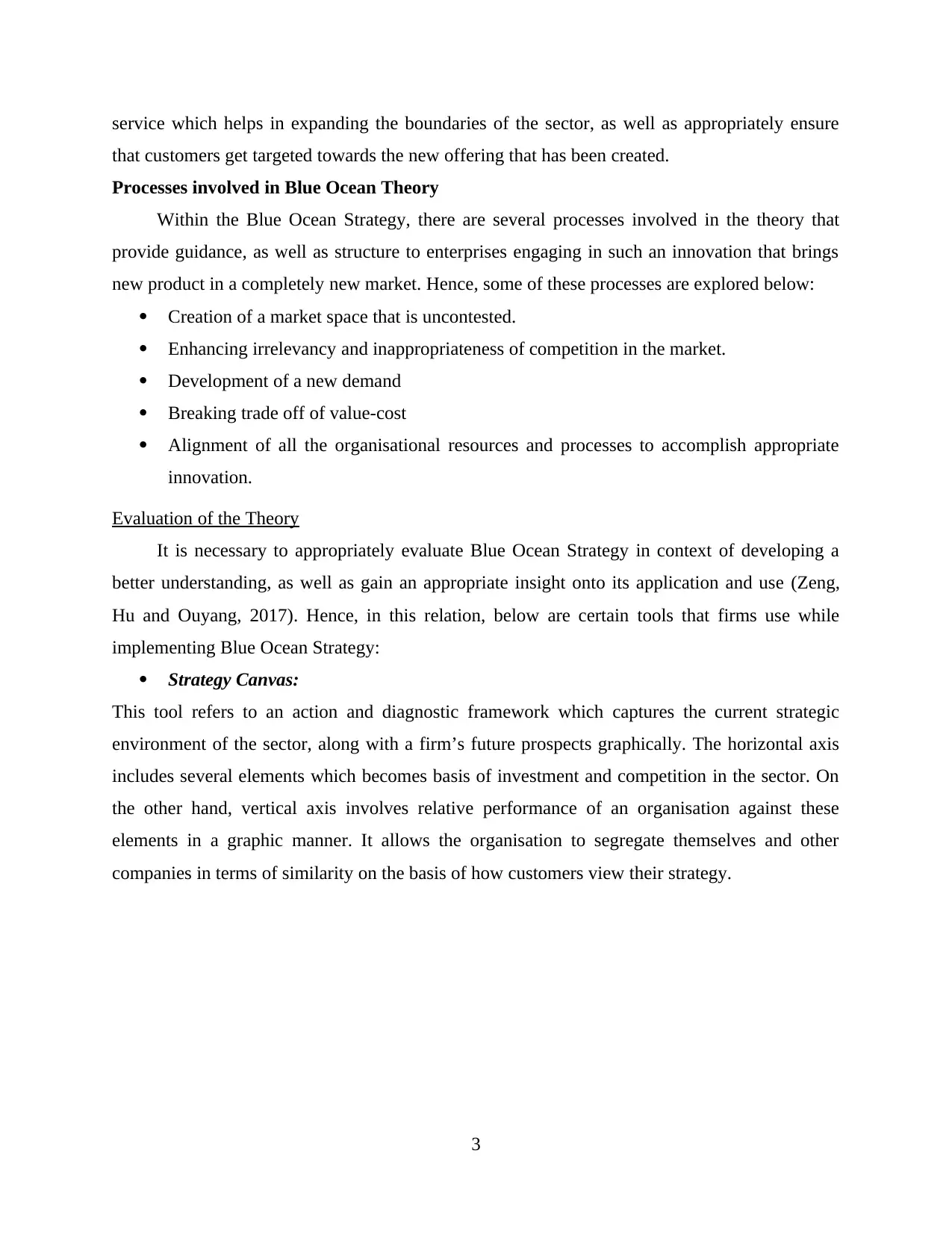
service which helps in expanding the boundaries of the sector, as well as appropriately ensure
that customers get targeted towards the new offering that has been created.
Processes involved in Blue Ocean Theory
Within the Blue Ocean Strategy, there are several processes involved in the theory that
provide guidance, as well as structure to enterprises engaging in such an innovation that brings
new product in a completely new market. Hence, some of these processes are explored below:
Creation of a market space that is uncontested.
Enhancing irrelevancy and inappropriateness of competition in the market.
Development of a new demand
Breaking trade off of value-cost
Alignment of all the organisational resources and processes to accomplish appropriate
innovation.
Evaluation of the Theory
It is necessary to appropriately evaluate Blue Ocean Strategy in context of developing a
better understanding, as well as gain an appropriate insight onto its application and use (Zeng,
Hu and Ouyang, 2017). Hence, in this relation, below are certain tools that firms use while
implementing Blue Ocean Strategy:
Strategy Canvas:
This tool refers to an action and diagnostic framework which captures the current strategic
environment of the sector, along with a firm’s future prospects graphically. The horizontal axis
includes several elements which becomes basis of investment and competition in the sector. On
the other hand, vertical axis involves relative performance of an organisation against these
elements in a graphic manner. It allows the organisation to segregate themselves and other
companies in terms of similarity on the basis of how customers view their strategy.
3
that customers get targeted towards the new offering that has been created.
Processes involved in Blue Ocean Theory
Within the Blue Ocean Strategy, there are several processes involved in the theory that
provide guidance, as well as structure to enterprises engaging in such an innovation that brings
new product in a completely new market. Hence, some of these processes are explored below:
Creation of a market space that is uncontested.
Enhancing irrelevancy and inappropriateness of competition in the market.
Development of a new demand
Breaking trade off of value-cost
Alignment of all the organisational resources and processes to accomplish appropriate
innovation.
Evaluation of the Theory
It is necessary to appropriately evaluate Blue Ocean Strategy in context of developing a
better understanding, as well as gain an appropriate insight onto its application and use (Zeng,
Hu and Ouyang, 2017). Hence, in this relation, below are certain tools that firms use while
implementing Blue Ocean Strategy:
Strategy Canvas:
This tool refers to an action and diagnostic framework which captures the current strategic
environment of the sector, along with a firm’s future prospects graphically. The horizontal axis
includes several elements which becomes basis of investment and competition in the sector. On
the other hand, vertical axis involves relative performance of an organisation against these
elements in a graphic manner. It allows the organisation to segregate themselves and other
companies in terms of similarity on the basis of how customers view their strategy.
3
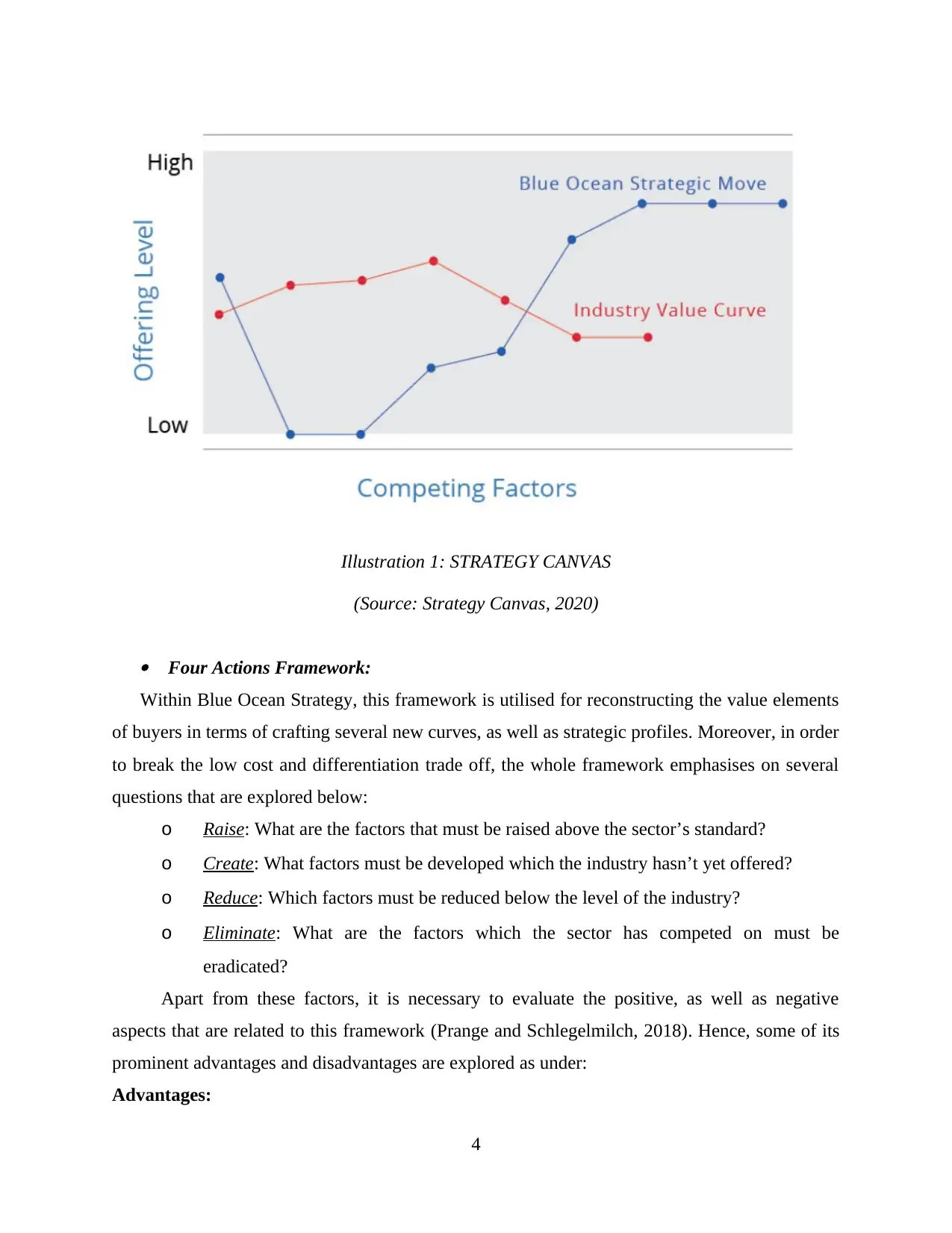
Illustration 1: STRATEGY CANVAS
(Source: Strategy Canvas, 2020)
Four Actions Framework:
Within Blue Ocean Strategy, this framework is utilised for reconstructing the value elements
of buyers in terms of crafting several new curves, as well as strategic profiles. Moreover, in order
to break the low cost and differentiation trade off, the whole framework emphasises on several
questions that are explored below:
o Raise: What are the factors that must be raised above the sector’s standard?
o Create: What factors must be developed which the industry hasn’t yet offered?
o Reduce: Which factors must be reduced below the level of the industry?
o Eliminate: What are the factors which the sector has competed on must be
eradicated?
Apart from these factors, it is necessary to evaluate the positive, as well as negative
aspects that are related to this framework (Prange and Schlegelmilch, 2018). Hence, some of its
prominent advantages and disadvantages are explored as under:
Advantages:
4
(Source: Strategy Canvas, 2020)
Four Actions Framework:
Within Blue Ocean Strategy, this framework is utilised for reconstructing the value elements
of buyers in terms of crafting several new curves, as well as strategic profiles. Moreover, in order
to break the low cost and differentiation trade off, the whole framework emphasises on several
questions that are explored below:
o Raise: What are the factors that must be raised above the sector’s standard?
o Create: What factors must be developed which the industry hasn’t yet offered?
o Reduce: Which factors must be reduced below the level of the industry?
o Eliminate: What are the factors which the sector has competed on must be
eradicated?
Apart from these factors, it is necessary to evaluate the positive, as well as negative
aspects that are related to this framework (Prange and Schlegelmilch, 2018). Hence, some of its
prominent advantages and disadvantages are explored as under:
Advantages:
4
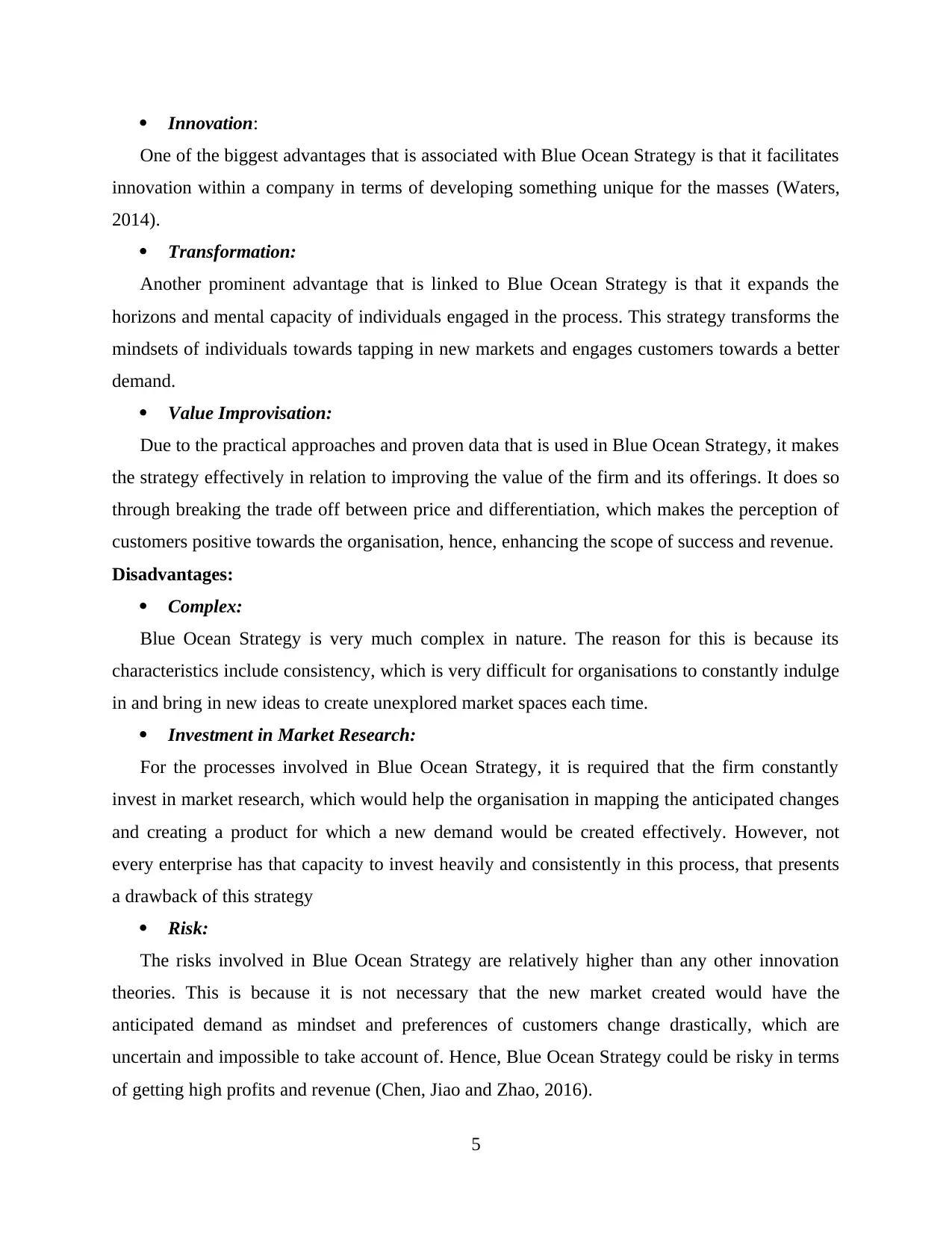
Innovation:
One of the biggest advantages that is associated with Blue Ocean Strategy is that it facilitates
innovation within a company in terms of developing something unique for the masses (Waters,
2014).
Transformation:
Another prominent advantage that is linked to Blue Ocean Strategy is that it expands the
horizons and mental capacity of individuals engaged in the process. This strategy transforms the
mindsets of individuals towards tapping in new markets and engages customers towards a better
demand.
Value Improvisation:
Due to the practical approaches and proven data that is used in Blue Ocean Strategy, it makes
the strategy effectively in relation to improving the value of the firm and its offerings. It does so
through breaking the trade off between price and differentiation, which makes the perception of
customers positive towards the organisation, hence, enhancing the scope of success and revenue.
Disadvantages:
Complex:
Blue Ocean Strategy is very much complex in nature. The reason for this is because its
characteristics include consistency, which is very difficult for organisations to constantly indulge
in and bring in new ideas to create unexplored market spaces each time.
Investment in Market Research:
For the processes involved in Blue Ocean Strategy, it is required that the firm constantly
invest in market research, which would help the organisation in mapping the anticipated changes
and creating a product for which a new demand would be created effectively. However, not
every enterprise has that capacity to invest heavily and consistently in this process, that presents
a drawback of this strategy
Risk:
The risks involved in Blue Ocean Strategy are relatively higher than any other innovation
theories. This is because it is not necessary that the new market created would have the
anticipated demand as mindset and preferences of customers change drastically, which are
uncertain and impossible to take account of. Hence, Blue Ocean Strategy could be risky in terms
of getting high profits and revenue (Chen, Jiao and Zhao, 2016).
5
One of the biggest advantages that is associated with Blue Ocean Strategy is that it facilitates
innovation within a company in terms of developing something unique for the masses (Waters,
2014).
Transformation:
Another prominent advantage that is linked to Blue Ocean Strategy is that it expands the
horizons and mental capacity of individuals engaged in the process. This strategy transforms the
mindsets of individuals towards tapping in new markets and engages customers towards a better
demand.
Value Improvisation:
Due to the practical approaches and proven data that is used in Blue Ocean Strategy, it makes
the strategy effectively in relation to improving the value of the firm and its offerings. It does so
through breaking the trade off between price and differentiation, which makes the perception of
customers positive towards the organisation, hence, enhancing the scope of success and revenue.
Disadvantages:
Complex:
Blue Ocean Strategy is very much complex in nature. The reason for this is because its
characteristics include consistency, which is very difficult for organisations to constantly indulge
in and bring in new ideas to create unexplored market spaces each time.
Investment in Market Research:
For the processes involved in Blue Ocean Strategy, it is required that the firm constantly
invest in market research, which would help the organisation in mapping the anticipated changes
and creating a product for which a new demand would be created effectively. However, not
every enterprise has that capacity to invest heavily and consistently in this process, that presents
a drawback of this strategy
Risk:
The risks involved in Blue Ocean Strategy are relatively higher than any other innovation
theories. This is because it is not necessary that the new market created would have the
anticipated demand as mindset and preferences of customers change drastically, which are
uncertain and impossible to take account of. Hence, Blue Ocean Strategy could be risky in terms
of getting high profits and revenue (Chen, Jiao and Zhao, 2016).
5
Paraphrase This Document
Need a fresh take? Get an instant paraphrase of this document with our AI Paraphraser
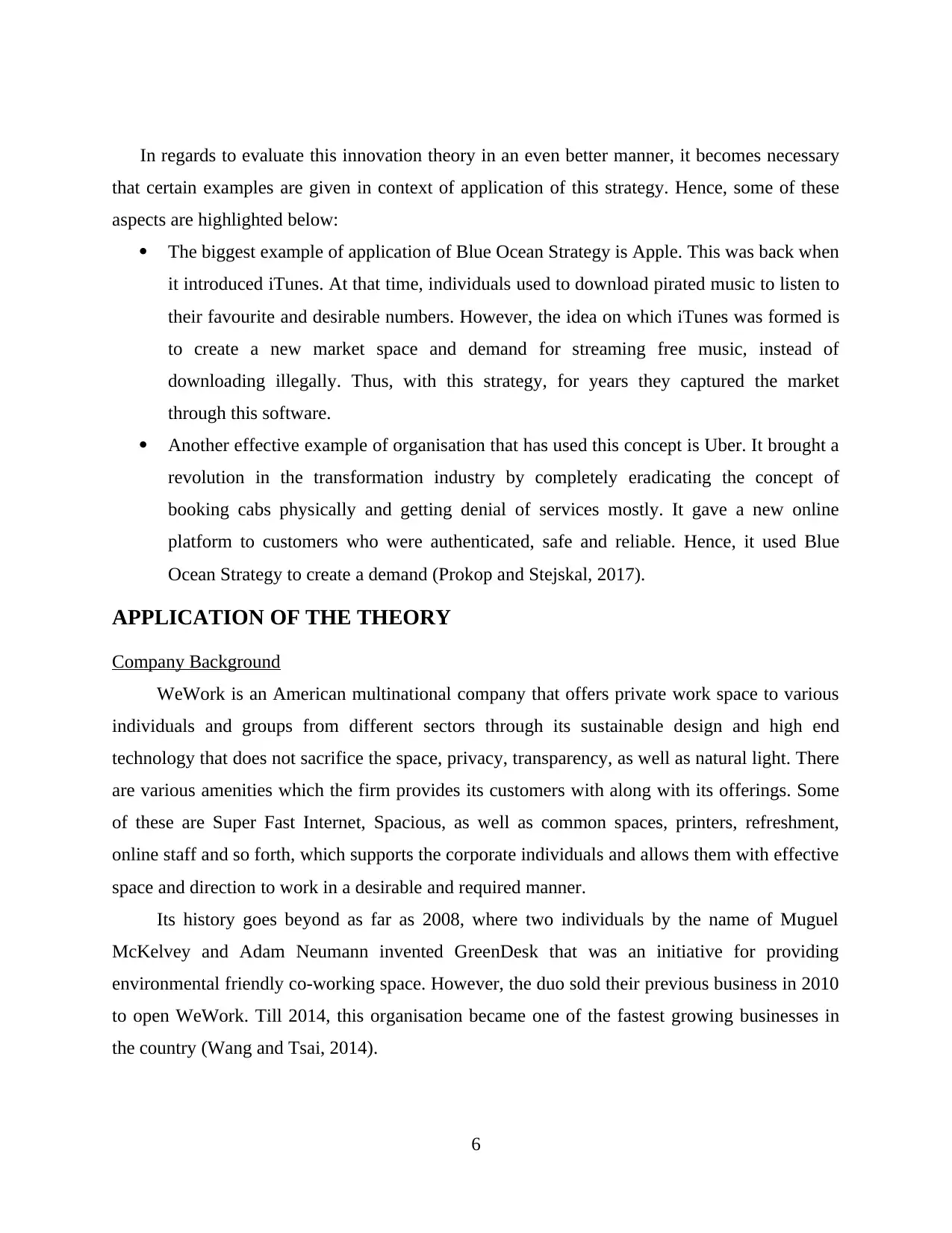
In regards to evaluate this innovation theory in an even better manner, it becomes necessary
that certain examples are given in context of application of this strategy. Hence, some of these
aspects are highlighted below:
The biggest example of application of Blue Ocean Strategy is Apple. This was back when
it introduced iTunes. At that time, individuals used to download pirated music to listen to
their favourite and desirable numbers. However, the idea on which iTunes was formed is
to create a new market space and demand for streaming free music, instead of
downloading illegally. Thus, with this strategy, for years they captured the market
through this software.
Another effective example of organisation that has used this concept is Uber. It brought a
revolution in the transformation industry by completely eradicating the concept of
booking cabs physically and getting denial of services mostly. It gave a new online
platform to customers who were authenticated, safe and reliable. Hence, it used Blue
Ocean Strategy to create a demand (Prokop and Stejskal, 2017).
APPLICATION OF THE THEORY
Company Background
WeWork is an American multinational company that offers private work space to various
individuals and groups from different sectors through its sustainable design and high end
technology that does not sacrifice the space, privacy, transparency, as well as natural light. There
are various amenities which the firm provides its customers with along with its offerings. Some
of these are Super Fast Internet, Spacious, as well as common spaces, printers, refreshment,
online staff and so forth, which supports the corporate individuals and allows them with effective
space and direction to work in a desirable and required manner.
Its history goes beyond as far as 2008, where two individuals by the name of Muguel
McKelvey and Adam Neumann invented GreenDesk that was an initiative for providing
environmental friendly co-working space. However, the duo sold their previous business in 2010
to open WeWork. Till 2014, this organisation became one of the fastest growing businesses in
the country (Wang and Tsai, 2014).
6
that certain examples are given in context of application of this strategy. Hence, some of these
aspects are highlighted below:
The biggest example of application of Blue Ocean Strategy is Apple. This was back when
it introduced iTunes. At that time, individuals used to download pirated music to listen to
their favourite and desirable numbers. However, the idea on which iTunes was formed is
to create a new market space and demand for streaming free music, instead of
downloading illegally. Thus, with this strategy, for years they captured the market
through this software.
Another effective example of organisation that has used this concept is Uber. It brought a
revolution in the transformation industry by completely eradicating the concept of
booking cabs physically and getting denial of services mostly. It gave a new online
platform to customers who were authenticated, safe and reliable. Hence, it used Blue
Ocean Strategy to create a demand (Prokop and Stejskal, 2017).
APPLICATION OF THE THEORY
Company Background
WeWork is an American multinational company that offers private work space to various
individuals and groups from different sectors through its sustainable design and high end
technology that does not sacrifice the space, privacy, transparency, as well as natural light. There
are various amenities which the firm provides its customers with along with its offerings. Some
of these are Super Fast Internet, Spacious, as well as common spaces, printers, refreshment,
online staff and so forth, which supports the corporate individuals and allows them with effective
space and direction to work in a desirable and required manner.
Its history goes beyond as far as 2008, where two individuals by the name of Muguel
McKelvey and Adam Neumann invented GreenDesk that was an initiative for providing
environmental friendly co-working space. However, the duo sold their previous business in 2010
to open WeWork. Till 2014, this organisation became one of the fastest growing businesses in
the country (Wang and Tsai, 2014).
6
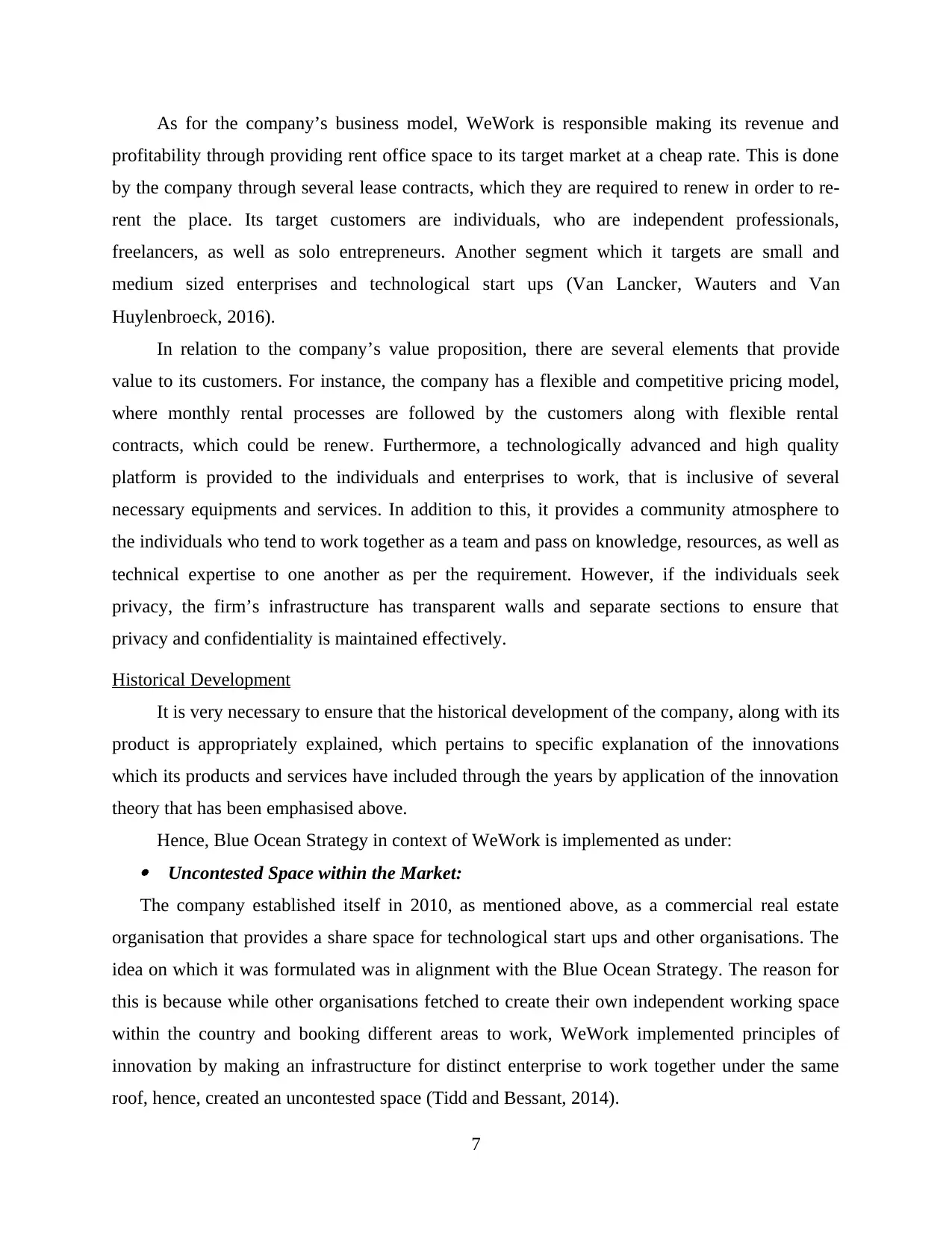
As for the company’s business model, WeWork is responsible making its revenue and
profitability through providing rent office space to its target market at a cheap rate. This is done
by the company through several lease contracts, which they are required to renew in order to re-
rent the place. Its target customers are individuals, who are independent professionals,
freelancers, as well as solo entrepreneurs. Another segment which it targets are small and
medium sized enterprises and technological start ups (Van Lancker, Wauters and Van
Huylenbroeck, 2016).
In relation to the company’s value proposition, there are several elements that provide
value to its customers. For instance, the company has a flexible and competitive pricing model,
where monthly rental processes are followed by the customers along with flexible rental
contracts, which could be renew. Furthermore, a technologically advanced and high quality
platform is provided to the individuals and enterprises to work, that is inclusive of several
necessary equipments and services. In addition to this, it provides a community atmosphere to
the individuals who tend to work together as a team and pass on knowledge, resources, as well as
technical expertise to one another as per the requirement. However, if the individuals seek
privacy, the firm’s infrastructure has transparent walls and separate sections to ensure that
privacy and confidentiality is maintained effectively.
Historical Development
It is very necessary to ensure that the historical development of the company, along with its
product is appropriately explained, which pertains to specific explanation of the innovations
which its products and services have included through the years by application of the innovation
theory that has been emphasised above.
Hence, Blue Ocean Strategy in context of WeWork is implemented as under: Uncontested Space within the Market:
The company established itself in 2010, as mentioned above, as a commercial real estate
organisation that provides a share space for technological start ups and other organisations. The
idea on which it was formulated was in alignment with the Blue Ocean Strategy. The reason for
this is because while other organisations fetched to create their own independent working space
within the country and booking different areas to work, WeWork implemented principles of
innovation by making an infrastructure for distinct enterprise to work together under the same
roof, hence, created an uncontested space (Tidd and Bessant, 2014).
7
profitability through providing rent office space to its target market at a cheap rate. This is done
by the company through several lease contracts, which they are required to renew in order to re-
rent the place. Its target customers are individuals, who are independent professionals,
freelancers, as well as solo entrepreneurs. Another segment which it targets are small and
medium sized enterprises and technological start ups (Van Lancker, Wauters and Van
Huylenbroeck, 2016).
In relation to the company’s value proposition, there are several elements that provide
value to its customers. For instance, the company has a flexible and competitive pricing model,
where monthly rental processes are followed by the customers along with flexible rental
contracts, which could be renew. Furthermore, a technologically advanced and high quality
platform is provided to the individuals and enterprises to work, that is inclusive of several
necessary equipments and services. In addition to this, it provides a community atmosphere to
the individuals who tend to work together as a team and pass on knowledge, resources, as well as
technical expertise to one another as per the requirement. However, if the individuals seek
privacy, the firm’s infrastructure has transparent walls and separate sections to ensure that
privacy and confidentiality is maintained effectively.
Historical Development
It is very necessary to ensure that the historical development of the company, along with its
product is appropriately explained, which pertains to specific explanation of the innovations
which its products and services have included through the years by application of the innovation
theory that has been emphasised above.
Hence, Blue Ocean Strategy in context of WeWork is implemented as under: Uncontested Space within the Market:
The company established itself in 2010, as mentioned above, as a commercial real estate
organisation that provides a share space for technological start ups and other organisations. The
idea on which it was formulated was in alignment with the Blue Ocean Strategy. The reason for
this is because while other organisations fetched to create their own independent working space
within the country and booking different areas to work, WeWork implemented principles of
innovation by making an infrastructure for distinct enterprise to work together under the same
roof, hence, created an uncontested space (Tidd and Bessant, 2014).
7
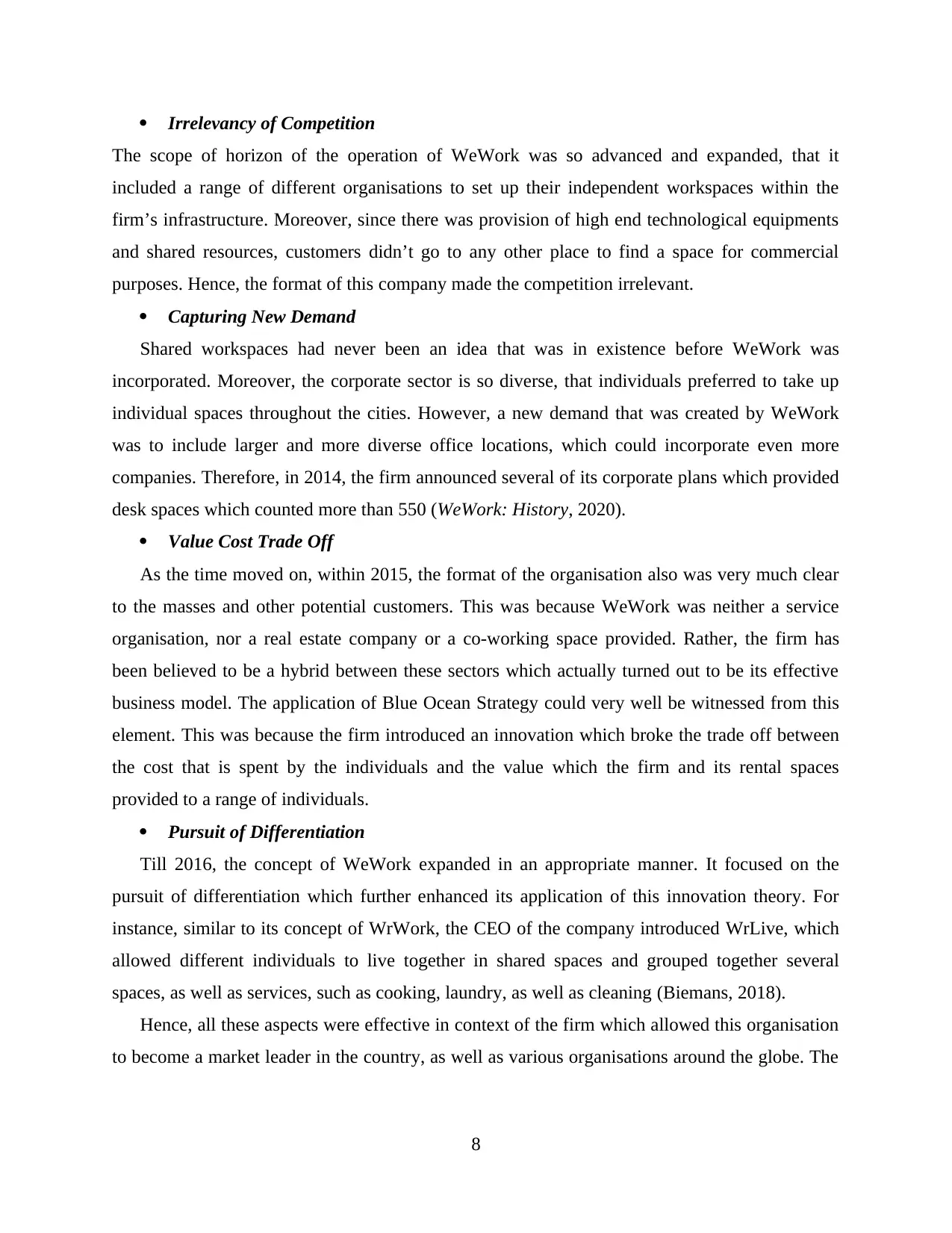
Irrelevancy of Competition
The scope of horizon of the operation of WeWork was so advanced and expanded, that it
included a range of different organisations to set up their independent workspaces within the
firm’s infrastructure. Moreover, since there was provision of high end technological equipments
and shared resources, customers didn’t go to any other place to find a space for commercial
purposes. Hence, the format of this company made the competition irrelevant.
Capturing New Demand
Shared workspaces had never been an idea that was in existence before WeWork was
incorporated. Moreover, the corporate sector is so diverse, that individuals preferred to take up
individual spaces throughout the cities. However, a new demand that was created by WeWork
was to include larger and more diverse office locations, which could incorporate even more
companies. Therefore, in 2014, the firm announced several of its corporate plans which provided
desk spaces which counted more than 550 (WeWork: History, 2020).
Value Cost Trade Off
As the time moved on, within 2015, the format of the organisation also was very much clear
to the masses and other potential customers. This was because WeWork was neither a service
organisation, nor a real estate company or a co-working space provided. Rather, the firm has
been believed to be a hybrid between these sectors which actually turned out to be its effective
business model. The application of Blue Ocean Strategy could very well be witnessed from this
element. This was because the firm introduced an innovation which broke the trade off between
the cost that is spent by the individuals and the value which the firm and its rental spaces
provided to a range of individuals.
Pursuit of Differentiation
Till 2016, the concept of WeWork expanded in an appropriate manner. It focused on the
pursuit of differentiation which further enhanced its application of this innovation theory. For
instance, similar to its concept of WrWork, the CEO of the company introduced WrLive, which
allowed different individuals to live together in shared spaces and grouped together several
spaces, as well as services, such as cooking, laundry, as well as cleaning (Biemans, 2018).
Hence, all these aspects were effective in context of the firm which allowed this organisation
to become a market leader in the country, as well as various organisations around the globe. The
8
The scope of horizon of the operation of WeWork was so advanced and expanded, that it
included a range of different organisations to set up their independent workspaces within the
firm’s infrastructure. Moreover, since there was provision of high end technological equipments
and shared resources, customers didn’t go to any other place to find a space for commercial
purposes. Hence, the format of this company made the competition irrelevant.
Capturing New Demand
Shared workspaces had never been an idea that was in existence before WeWork was
incorporated. Moreover, the corporate sector is so diverse, that individuals preferred to take up
individual spaces throughout the cities. However, a new demand that was created by WeWork
was to include larger and more diverse office locations, which could incorporate even more
companies. Therefore, in 2014, the firm announced several of its corporate plans which provided
desk spaces which counted more than 550 (WeWork: History, 2020).
Value Cost Trade Off
As the time moved on, within 2015, the format of the organisation also was very much clear
to the masses and other potential customers. This was because WeWork was neither a service
organisation, nor a real estate company or a co-working space provided. Rather, the firm has
been believed to be a hybrid between these sectors which actually turned out to be its effective
business model. The application of Blue Ocean Strategy could very well be witnessed from this
element. This was because the firm introduced an innovation which broke the trade off between
the cost that is spent by the individuals and the value which the firm and its rental spaces
provided to a range of individuals.
Pursuit of Differentiation
Till 2016, the concept of WeWork expanded in an appropriate manner. It focused on the
pursuit of differentiation which further enhanced its application of this innovation theory. For
instance, similar to its concept of WrWork, the CEO of the company introduced WrLive, which
allowed different individuals to live together in shared spaces and grouped together several
spaces, as well as services, such as cooking, laundry, as well as cleaning (Biemans, 2018).
Hence, all these aspects were effective in context of the firm which allowed this organisation
to become a market leader in the country, as well as various organisations around the globe. The
8
Secure Best Marks with AI Grader
Need help grading? Try our AI Grader for instant feedback on your assignments.
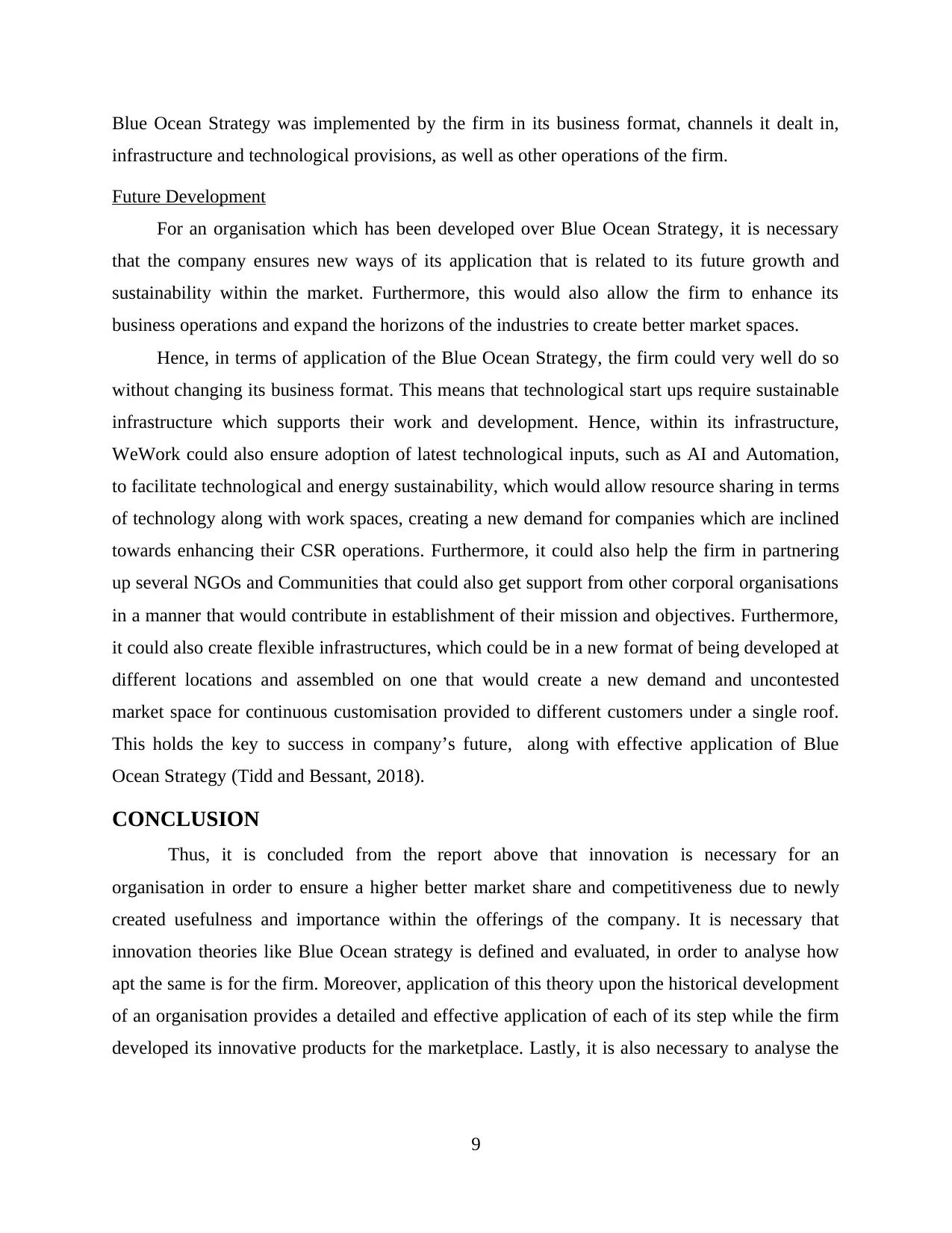
Blue Ocean Strategy was implemented by the firm in its business format, channels it dealt in,
infrastructure and technological provisions, as well as other operations of the firm.
Future Development
For an organisation which has been developed over Blue Ocean Strategy, it is necessary
that the company ensures new ways of its application that is related to its future growth and
sustainability within the market. Furthermore, this would also allow the firm to enhance its
business operations and expand the horizons of the industries to create better market spaces.
Hence, in terms of application of the Blue Ocean Strategy, the firm could very well do so
without changing its business format. This means that technological start ups require sustainable
infrastructure which supports their work and development. Hence, within its infrastructure,
WeWork could also ensure adoption of latest technological inputs, such as AI and Automation,
to facilitate technological and energy sustainability, which would allow resource sharing in terms
of technology along with work spaces, creating a new demand for companies which are inclined
towards enhancing their CSR operations. Furthermore, it could also help the firm in partnering
up several NGOs and Communities that could also get support from other corporal organisations
in a manner that would contribute in establishment of their mission and objectives. Furthermore,
it could also create flexible infrastructures, which could be in a new format of being developed at
different locations and assembled on one that would create a new demand and uncontested
market space for continuous customisation provided to different customers under a single roof.
This holds the key to success in company’s future, along with effective application of Blue
Ocean Strategy (Tidd and Bessant, 2018).
CONCLUSION
Thus, it is concluded from the report above that innovation is necessary for an
organisation in order to ensure a higher better market share and competitiveness due to newly
created usefulness and importance within the offerings of the company. It is necessary that
innovation theories like Blue Ocean strategy is defined and evaluated, in order to analyse how
apt the same is for the firm. Moreover, application of this theory upon the historical development
of an organisation provides a detailed and effective application of each of its step while the firm
developed its innovative products for the marketplace. Lastly, it is also necessary to analyse the
9
infrastructure and technological provisions, as well as other operations of the firm.
Future Development
For an organisation which has been developed over Blue Ocean Strategy, it is necessary
that the company ensures new ways of its application that is related to its future growth and
sustainability within the market. Furthermore, this would also allow the firm to enhance its
business operations and expand the horizons of the industries to create better market spaces.
Hence, in terms of application of the Blue Ocean Strategy, the firm could very well do so
without changing its business format. This means that technological start ups require sustainable
infrastructure which supports their work and development. Hence, within its infrastructure,
WeWork could also ensure adoption of latest technological inputs, such as AI and Automation,
to facilitate technological and energy sustainability, which would allow resource sharing in terms
of technology along with work spaces, creating a new demand for companies which are inclined
towards enhancing their CSR operations. Furthermore, it could also help the firm in partnering
up several NGOs and Communities that could also get support from other corporal organisations
in a manner that would contribute in establishment of their mission and objectives. Furthermore,
it could also create flexible infrastructures, which could be in a new format of being developed at
different locations and assembled on one that would create a new demand and uncontested
market space for continuous customisation provided to different customers under a single roof.
This holds the key to success in company’s future, along with effective application of Blue
Ocean Strategy (Tidd and Bessant, 2018).
CONCLUSION
Thus, it is concluded from the report above that innovation is necessary for an
organisation in order to ensure a higher better market share and competitiveness due to newly
created usefulness and importance within the offerings of the company. It is necessary that
innovation theories like Blue Ocean strategy is defined and evaluated, in order to analyse how
apt the same is for the firm. Moreover, application of this theory upon the historical development
of an organisation provides a detailed and effective application of each of its step while the firm
developed its innovative products for the marketplace. Lastly, it is also necessary to analyse the
9
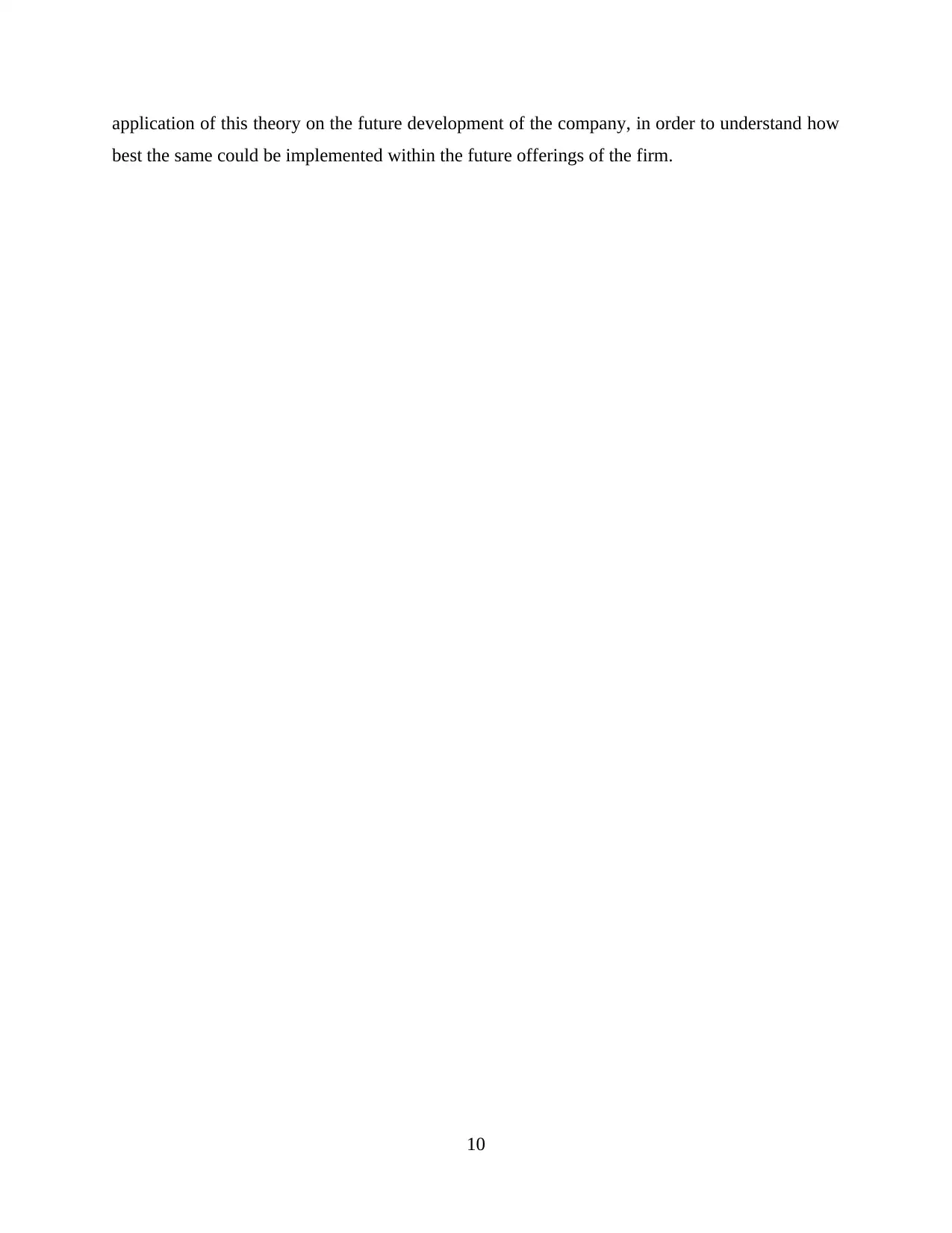
application of this theory on the future development of the company, in order to understand how
best the same could be implemented within the future offerings of the firm.
10
best the same could be implemented within the future offerings of the firm.
10
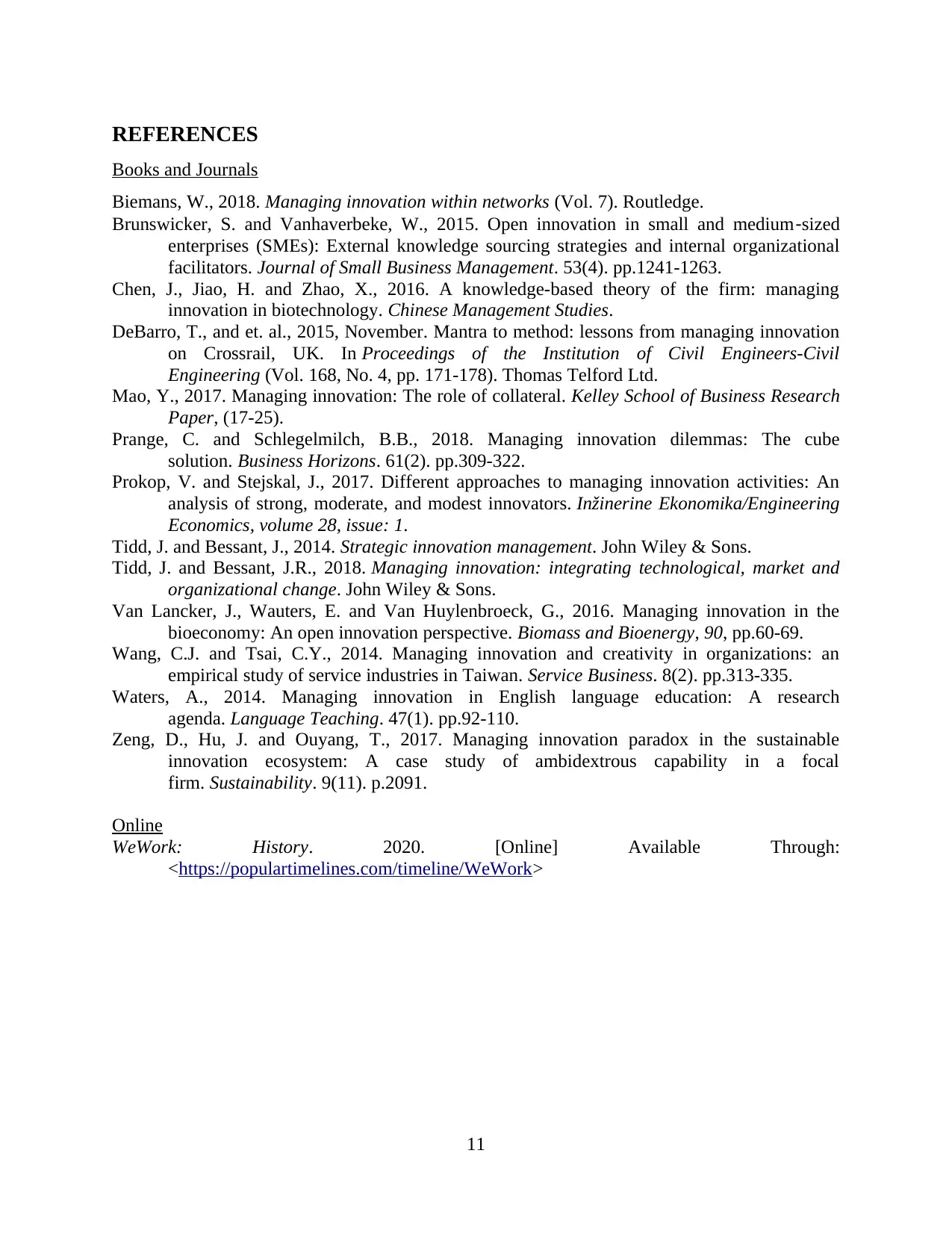
REFERENCES
Books and Journals
Biemans, W., 2018. Managing innovation within networks (Vol. 7). Routledge.
Brunswicker, S. and Vanhaverbeke, W., 2015. Open innovation in small and medium‐sized
enterprises (SMEs): External knowledge sourcing strategies and internal organizational
facilitators. Journal of Small Business Management. 53(4). pp.1241-1263.
Chen, J., Jiao, H. and Zhao, X., 2016. A knowledge-based theory of the firm: managing
innovation in biotechnology. Chinese Management Studies.
DeBarro, T., and et. al., 2015, November. Mantra to method: lessons from managing innovation
on Crossrail, UK. In Proceedings of the Institution of Civil Engineers-Civil
Engineering (Vol. 168, No. 4, pp. 171-178). Thomas Telford Ltd.
Mao, Y., 2017. Managing innovation: The role of collateral. Kelley School of Business Research
Paper, (17-25).
Prange, C. and Schlegelmilch, B.B., 2018. Managing innovation dilemmas: The cube
solution. Business Horizons. 61(2). pp.309-322.
Prokop, V. and Stejskal, J., 2017. Different approaches to managing innovation activities: An
analysis of strong, moderate, and modest innovators. Inžinerine Ekonomika/Engineering
Economics, volume 28, issue: 1.
Tidd, J. and Bessant, J., 2014. Strategic innovation management. John Wiley & Sons.
Tidd, J. and Bessant, J.R., 2018. Managing innovation: integrating technological, market and
organizational change. John Wiley & Sons.
Van Lancker, J., Wauters, E. and Van Huylenbroeck, G., 2016. Managing innovation in the
bioeconomy: An open innovation perspective. Biomass and Bioenergy, 90, pp.60-69.
Wang, C.J. and Tsai, C.Y., 2014. Managing innovation and creativity in organizations: an
empirical study of service industries in Taiwan. Service Business. 8(2). pp.313-335.
Waters, A., 2014. Managing innovation in English language education: A research
agenda. Language Teaching. 47(1). pp.92-110.
Zeng, D., Hu, J. and Ouyang, T., 2017. Managing innovation paradox in the sustainable
innovation ecosystem: A case study of ambidextrous capability in a focal
firm. Sustainability. 9(11). p.2091.
Online
WeWork: History. 2020. [Online] Available Through:
<https://populartimelines.com/timeline/WeWork>
11
Books and Journals
Biemans, W., 2018. Managing innovation within networks (Vol. 7). Routledge.
Brunswicker, S. and Vanhaverbeke, W., 2015. Open innovation in small and medium‐sized
enterprises (SMEs): External knowledge sourcing strategies and internal organizational
facilitators. Journal of Small Business Management. 53(4). pp.1241-1263.
Chen, J., Jiao, H. and Zhao, X., 2016. A knowledge-based theory of the firm: managing
innovation in biotechnology. Chinese Management Studies.
DeBarro, T., and et. al., 2015, November. Mantra to method: lessons from managing innovation
on Crossrail, UK. In Proceedings of the Institution of Civil Engineers-Civil
Engineering (Vol. 168, No. 4, pp. 171-178). Thomas Telford Ltd.
Mao, Y., 2017. Managing innovation: The role of collateral. Kelley School of Business Research
Paper, (17-25).
Prange, C. and Schlegelmilch, B.B., 2018. Managing innovation dilemmas: The cube
solution. Business Horizons. 61(2). pp.309-322.
Prokop, V. and Stejskal, J., 2017. Different approaches to managing innovation activities: An
analysis of strong, moderate, and modest innovators. Inžinerine Ekonomika/Engineering
Economics, volume 28, issue: 1.
Tidd, J. and Bessant, J., 2014. Strategic innovation management. John Wiley & Sons.
Tidd, J. and Bessant, J.R., 2018. Managing innovation: integrating technological, market and
organizational change. John Wiley & Sons.
Van Lancker, J., Wauters, E. and Van Huylenbroeck, G., 2016. Managing innovation in the
bioeconomy: An open innovation perspective. Biomass and Bioenergy, 90, pp.60-69.
Wang, C.J. and Tsai, C.Y., 2014. Managing innovation and creativity in organizations: an
empirical study of service industries in Taiwan. Service Business. 8(2). pp.313-335.
Waters, A., 2014. Managing innovation in English language education: A research
agenda. Language Teaching. 47(1). pp.92-110.
Zeng, D., Hu, J. and Ouyang, T., 2017. Managing innovation paradox in the sustainable
innovation ecosystem: A case study of ambidextrous capability in a focal
firm. Sustainability. 9(11). p.2091.
Online
WeWork: History. 2020. [Online] Available Through:
<https://populartimelines.com/timeline/WeWork>
11
1 out of 13
Related Documents
Your All-in-One AI-Powered Toolkit for Academic Success.
+13062052269
info@desklib.com
Available 24*7 on WhatsApp / Email
![[object Object]](/_next/static/media/star-bottom.7253800d.svg)
Unlock your academic potential
© 2024 | Zucol Services PVT LTD | All rights reserved.




